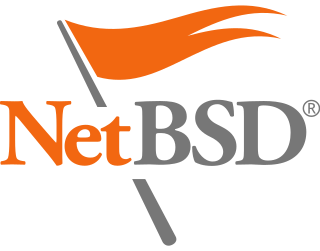Related Research Articles

In computer science, a microkernel is the near-minimum amount of software that can provide the mechanisms needed to implement an operating system (OS). These mechanisms include low-level address space management, thread management, and inter-process communication (IPC).
Mach is a kernel developed at Carnegie Mellon University by Richard Rashid and Avie Tevanian to support operating system research, primarily distributed and parallel computing. Mach is often considered one of the earliest examples of a microkernel. However, not all versions of Mach are microkernels. Mach's derivatives are the basis of the operating system kernel in GNU Hurd and of Apple's XNU kernel used in macOS, iOS, iPadOS, tvOS, and watchOS.

In computer science, a thread of execution is the smallest sequence of programmed instructions that can be managed independently by a scheduler, which is typically a part of the operating system. In many cases, a thread is a component of a process.

In computing, a system call is the programmatic way in which a computer program requests a service from the operating system on which it is executed. This may include hardware-related services, creation and execution of new processes, and communication with integral kernel services such as process scheduling. System calls provide an essential interface between a process and the operating system.
In computing, scheduling is the action of assigning resources to perform tasks. The resources may be processors, network links or expansion cards. The tasks may be threads, processes or data flows.

DragonFly BSD is a free and open-source Unix-like operating system forked from FreeBSD 4.8. Matthew Dillon, an Amiga developer in the late 1980s and early 1990s and FreeBSD developer between 1994 and 2003, began working on DragonFly BSD in June 2003 and announced it on the FreeBSD mailing lists on 16 July 2003.
Light Weight Kernel Threads (LWKT) is a computer science term and from DragonFly BSD in particular. LWKTs differ from normal kernel threads in that they can preempt normal kernel threads. According to Matt Dillon, DragonFlyBSD creator:
The LWKT scheduler is responsible for actually running a thread. It uses a fixed priority scheme, but the fixed priorities are differentiating major subsystems, not user processes. For example, hardware interrupt threads have the highest priority, followed by software interrupts, kernel-only threads, then finally user threads. A user thread either runs at user-kernel priority, or a user thread runs at user priority.
DragonFly does preempt, it just does it very carefully and only under particular circumstances. An LWKT interrupt thread can preempt most other threads, for example. This mimics what FreeBSD-4.x already did with its spl/run-interrupt-in-context-of-current-process mechanism. What DragonFly does *NOT* do is allow a non-interrupt kernel thread to preempt another non-interrupt kernel thread.
The mainframe z/OS Operating system supports a similar mechanism, called SRB.
SRB's represent requests to execute a system service routine. SRB's are typically created when one address space detects an event that affects a different address space; they provide one of several mechanisms for asynchronous inter-address space communication for programs running on z/OS.
An SRB is similar to a Process Control Block (PCB), in that it identifies a unit of work to the system. Unlike a PCB, an SRB cannot "own" storage areas. In a multiprocessor environment, the SRB routine, after being scheduled, can be dispatched on another processor and can run concurrently with the scheduling program. The scheduling program can continue to do other processing in parallel with the SRB routine. Only programs running in kernel mode can create an SRB.
The Windows Operating System knows a similar light weight thread mechanism named "fibers". Fibers are scheduled by an application program. The port of the CICS Transaction Server to the Windows platform uses fibers, somewhat analogous to the use of "enclaves" under z/OS.
In UNIX, "kernel threads" have two threads, one is the core thread, one is the user thread.
The Native POSIX Thread Library (NPTL) is an implementation of the POSIX Threads specification for the Linux operating system.
Capability-based security is a concept in the design of secure computing systems, one of the existing security models. A capability is a communicable, unforgeable token of authority. It refers to a value that references an object along with an associated set of access rights. A user program on a capability-based operating system must use a capability to access an object. Capability-based security refers to the principle of designing user programs such that they directly share capabilities with each other according to the principle of least privilege, and to the operating system infrastructure necessary to make such transactions efficient and secure. Capability-based security is to be contrasted with an approach that uses traditional UNIX permissions and Access Control Lists.
In computer security, mandatory access control (MAC) refers to a type of access control by which the operating system or database constrains the ability of a subject or initiator to access or generally perform some sort of operation on an object or target. In the case of operating systems, a subject is usually a process or thread; objects are constructs such as files, directories, TCP/UDP ports, shared memory segments, IO devices, etc. Subjects and objects each have a set of security attributes. Whenever a subject attempts to access an object, an authorization rule enforced by the operating system kernel examines these security attributes and decides whether the access can take place. Any operation by any subject on any object is tested against the set of authorization rules to determine if the operation is allowed. A database management system, in its access control mechanism, can also apply mandatory access control; in this case, the objects are tables, views, procedures, etc.
These tables provide a comparison of operating systems, of computer devices, as listing general and technical information for a number of widely used and currently available PC or handheld operating systems. The article "Usage share of operating systems" provides a broader, and more general, comparison of operating systems that includes servers, mainframes and supercomputers.
OS-level virtualization is an operating system (OS) virtualization paradigm in which the kernel allows the existence of multiple isolated user space instances, called containers, zones, virtual private servers (OpenVZ), partitions, virtual environments (VEs), virtual kernels, or jails. Such instances may look like real computers from the point of view of programs running in them. A computer program running on an ordinary operating system can see all resources of that computer. However, programs running inside of a container can only see the container's contents and devices assigned to the container.

Binary Modular Dataflow Machine (BMDFM) is a software package that enables running an application in parallel on shared memory symmetric multiprocessing (SMP) computers using the multiple processors to speed up the execution of single applications. BMDFM automatically identifies and exploits parallelism due to the static and mainly dynamic scheduling of the dataflow instruction sequences derived from the formerly sequential program.
In computer operating systems, a light-weight process (LWP) is a means of achieving multitasking. In the traditional meaning of the term, as used in Unix System V and Solaris, a LWP runs in user space on top of a single kernel thread and shares its address space and system resources with other LWPs within the same process. Multiple user-level threads, managed by a thread library, can be placed on top of one or many LWPs - allowing multitasking to be done at the user level, which can have some performance benefits.

FreeBSD is a free and open-source Unix-like operating system descended from the Berkeley Software Distribution (BSD). The first version of FreeBSD was released in 1993 developed from 386BSD and the current version runs on x86, ARM, PowerPC and RISC-V processors. The project is supported and promoted by the FreeBSD Foundation.
In computer programming, a green thread is a thread that is scheduled by a runtime library or virtual machine (VM) instead of natively by the underlying operating system (OS). Green threads emulate multithreaded environments without relying on any native OS abilities, and they are managed in user space instead of kernel space, enabling them to work in environments that do not have native thread support.
The Berkeley Packet Filter is a network tap and packet filter which permits computer network packets to be captured and filtered at the operating system level. It provides a raw interface to data link layers, permitting raw link-layer packets to be sent and received, and allows a userspace process to supply a filter program that specifies which packets it wants to receive. For example, a tcpdump process may want to receive only packets that initiate a TCP connection. BPF returns only packets that pass the filter that the process supplies. This avoids copying unwanted packets from the operating system kernel to the process, greatly improving performance. The filter program is in the form of instructions for a virtual machine, which are interpreted, or compiled into machine code by a just-in-time (JIT) mechanism and executed, in the kernel.
In operating systems, a giant lock, also known as a big-lock or kernel-lock, is a lock that may be used in the kernel to provide concurrency control required by symmetric multiprocessing (SMP) systems.

The kernel is a computer program at the core of a computer's operating system and generally has complete control over everything in the system. The kernel is also responsible for preventing and mitigating conflicts between different processes. It is the portion of the operating system code that is always resident in memory and facilitates interactions between hardware and software components. A full kernel controls all hardware resources via device drivers, arbitrates conflicts between processes concerning such resources, and optimizes the utilization of common resources e.g. CPU & cache usage, file systems, and network sockets. On most systems, the kernel is one of the first programs loaded on startup. It handles the rest of startup as well as memory, peripherals, and input/output (I/O) requests from software, translating them into data-processing instructions for the central processing unit.

NetBSD is a free and open-source Unix operating system based on the Berkeley Software Distribution (BSD). It was the first open-source BSD descendant officially released after 386BSD was forked. It continues to be actively developed and is available for many platforms, including servers, desktops, handheld devices, and embedded systems.
References
- ↑ Anderson, Thomas E.; Bershad, Brian N.; Lazowska, Edward D.; Levy, Henry M. (September 1991). "Scheduler activations: Effective kernel support for the user-level management of parallelism". Proceedings of the thirteenth ACM symposium on Operating systems principles. pp. 95–109. doi:10.1145/121132.121151. ISBN 0897914473. S2CID 264864317.
- ↑ An Implementation of Scheduler Activations on the NetBSD Operating System
- ↑ Significant changes from NetBSD 4.0 to 5.0